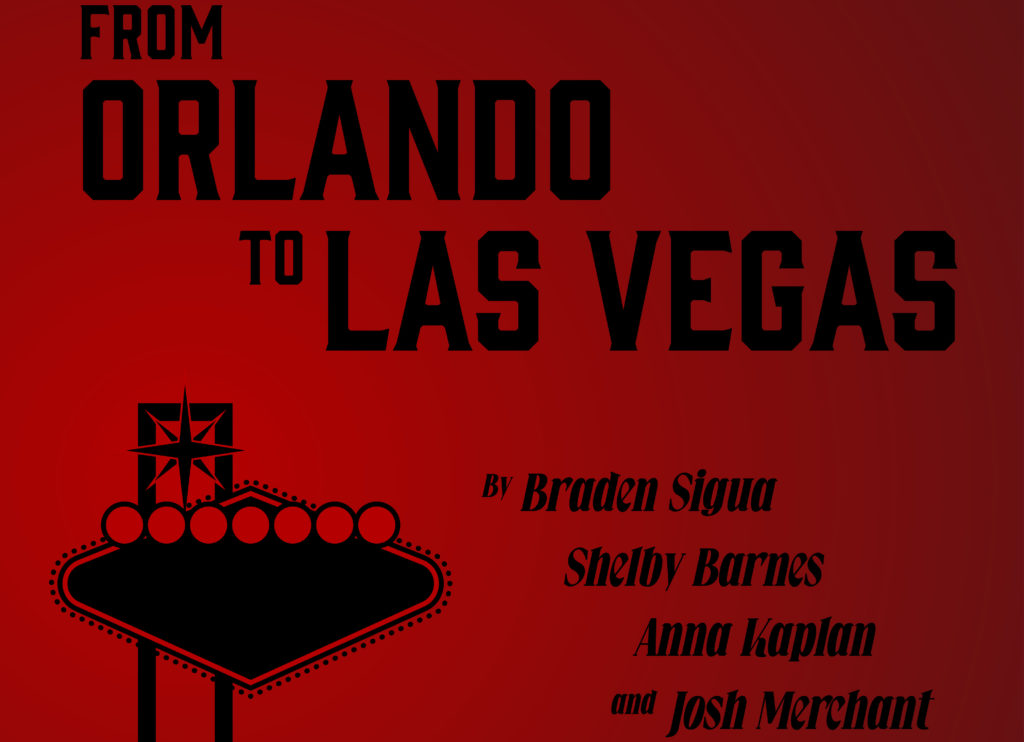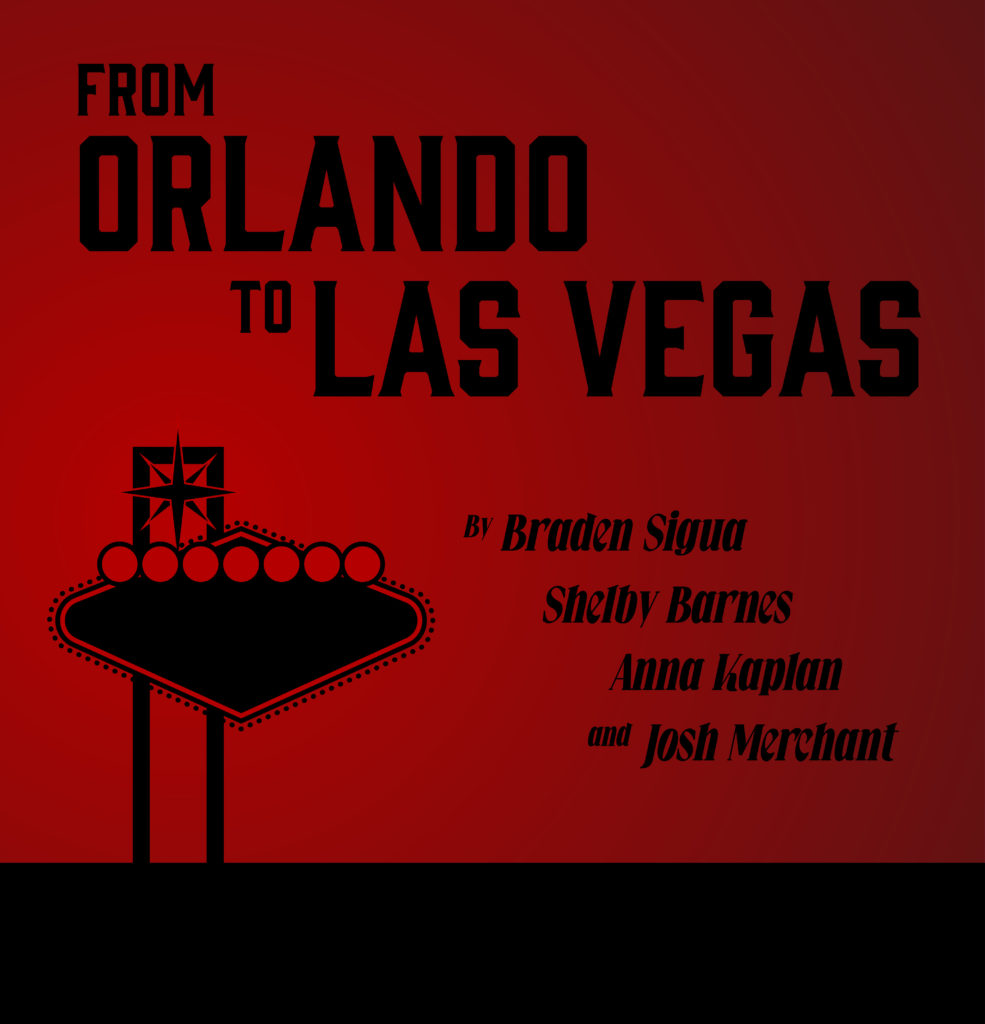An Era of Violence: The Post 9/11 Generation
Note from the Editor: This article was co-written by Shelby Barnes, and Anna Kaplan, Josh Merchant and Braden Sigua, although we are currently unable to display multiple authors’ names due to technical difficulties.
Every morning I take a shower, get some drip coffee from C-Street and go to class. Repeating these steps has become the norm for me; repetition in my life gives me comfort. Finding normalcy in comfort is only human, but I worry about what happens to a society that finds normalcy in gun violence.
When I woke up Sunday morning to news about the shooting in Las Vegas, I felt something that was scarily close to indifference. It’s not that I didn’t care, but I have become so familiarized with mass shootings, they have become almost normal to me. I want to be more upset, but instead I responded to the 58 dead and hundreds wounded with a sigh and a shake of my head. Devastation via bullet has become the norm of our country.
Mass shootings in the U.S. happen with such frequency, that there’s no time to grieve or absorb its magnitude because the next shooting is days away, and that is not an exaggeration. If indifference becomes the common response to tragedy, then this culture won’t improve. How can we strive to create a better world when tragedy is overwhelmingly commonplace? I don’t have an answer, but maybe a compromise.
I’m not asking anyone to be hyper aware of the news or dedicate all their time to political activism, but I am asking us to please lean into those emotions when tragedy occurs. There’s a middle ground between being ignorant to the issues or getting burned out, and I think it lies in sitting with these feelings. Please, be uncomfortable and angry with these shootings, they are not instances that should be normal or repeated, and we need to be changed by these experiences.
– Braden Sigua
Race and Religion
On April 15, 2013, two bombs were set off at the finish of the Boston Marathon. Three dead, 264 wounded. The bombers responsible, Tamerlan and Dzhokhar Tsarnaev, were both classified as terrorists.
On June 12, 2016, a shooting at an Orlando gay night club took the lives of 49 people. At the time, this was the second deadliest shooting in the United states. The shooter, Afghani-American Omar Mateen, was classified as a terrorist.
On October 1, 2017, Stephen Paddock shot into a crowd of concertgoers from his hotel room during the Route 91 Harvest Festival. 58 were found dead, and over 500 were injured. Paddock was thought to be mentally ill by investigators.
In a legal definition, terrorism is “violent acts or acts dangerous to human life that are a violation of criminal laws of the United States.” The law delineates acts of terror from other mass acts of destruction on the basis of the perpetrator’s motive; strictly defining terrorism as being politically or ideologically motivated. Yet, the question still stands when horrific acts and how we label them are faced with racial correlations—to what degree are these acts constituted as dangerous? How much terror must be elicited from a population to deem an act “terrorism?” And how many lives must be lost before the term ‘terrorism’ applies?
“If indifference becomes the response to tragedy, then this culture won’t improve.”
–Braden Sigua
CNN reported that the U.S. takes the lead in the most mass public shootings over any other country in the world. With Las Vegas ranked as the country’s deadliest shooting, public outcry was not only rooted in the tragedy that took place, but resistance from media and politicians to classify this as a terrorist attack. This complicated issue sits at the confluence of race, religion and terrorism itself. One could argue that the most pertinent component is the color of the perpretrator’s skin.
From Facebook to Snapchat, users questioned what it takes to be a terrorist, some hypothesizing that—had Paddock been a person of color—the word would have been used to describe him.
Senior Political Science major Kate Saavedra was one of many who questioned what it means to be a terrorist in modern America and the notion that race is one determining factor in making this classification.
“As a country and as a culture or society, we’re scared of Muslims and we’re scared of brown people.” said Saavedra. “9/11 put us in the minds that those things are not mutually exclusive. That one event made us connect that together and we can’t disconnect them.”
Saavedra further noted that when a white perpetrator carries out a shooting, bombing or community attack, the public is often hesitant to identify the individual as a terrorist.
“We don’t, in the U.S., call white people terrorists, ever. Even though they can be, a lot of shootings and bombings and attacks on communities are not labeled terrorism when they’re carried out by a white person.”
So what makes a terrorist? The degree of their crime or the color of their skin? Tamerlan Tsarnaev, Dzhokhar Tsarnaev and Omar Mateen were Muslim. Stephen Paddock was white. Though all parties committed unimaginable acts, they still are weighted differently by one critical factor: terrorism. The Tsarnaev brothers and Mateen were terrorists, but Paddock was not.
It’s an era that questions what war we’re fighting. A war on terrorism, or war on race?
Violence and the Media
A vigil was held at the Chapel of St. Ignatius last Thursday to remember the victims of the Las Vegas shooting. Campus Ministry, along with The Student Government of Seattle University (SGSU) helped plan the vigil in an effort to help students cope with the tragedy.
SGSU’s Internal Chief of Staff Karina Cole helped organize the vigil to support students as they processed what happened in Las Vegas.
“We’ve come to this normalized response to what happens when there’s a shooting,” Cole said. “[An email] doesn’t do justice to the people who died, and it devalues and minimizes the impact of what just occurred. It doesn’t allow students the time to take in [that] this was the biggest shooting in United States history ever, and it is really scary that we’ve become apathetic towards things like that.”
No empirical studies have been completed yet to affirm if constant images of violence have caused emotional apathy within the post-9/11 generation. This is because time hasn’t allowed for any kind of long-term study.
However, Criminal Justice professor Jacqueline Helfgott said that there have already been studies showing the effects of mass violence on people dating back to the 1980s, and images of violence in the media have skyrocketed in the past 35 years. This is what researchers call “media-mediated violence,” because the media determine how much violencepeople see.
“The way we’re all inundated with ‘media-mediated’ messages of violence can make their way into people’s thought patterns and thinking errors, and potentially set them off in ways that may not have been possible in a previous time period,” Helfgott said.
Helfgott said the growing effect of technology and social media on human behavior cannot be overlooked in terms of mass shootings. She added that the rise in images of violence in media can exacerbate the copycat effect, because it can push what she calls “edge-sitters,” or people who have thought about committing crimes, to become “actors” or people who actually commit crimes. The media contribute to this phenomenon because of how they report on mass shooters—making ordinary people celebrities, feeding into edge-sitters’ power complexes.
“People who may be less sensitive to these images create…[a] media-mediated relationship to violence,” Helfgott said. “This is of great concern, because if we’re all seeing media images of violence, which hopefully is what most of us actually see, then we don’t have a very realistic understanding of what actual violence is.”
The way the general public is constantly inundated and almost assaulted with constant images of violence can affect the general public in two ways.
“This was the biggest shooting in United States history ever, and it is really scary that we’ve become apathetic to that.”
–Karina Cole
The first is that people become vicarious victims—meaning that certain people will begin to think that the likelihood of being involved in a crime is much higher than the actual statistical probability. On the other hand, this effect can actually desensitize people from fully understanding the harmful and terminal effects of violence.
Politics and the Constitution
From a political perspective, the issue of gun control and legislation runs much deeper than just the opinions of the general public.
According to Political Science instructor Patrick Schoettmer, the majority of Americans believe that gun restrictions should be expanded in some way. However, that simple majority isn’t necessarily enough to make a change.
“People who are opposed to expanding background checks vote on only that issue; whereas people who support it generally support it, but that’s not what they focus on or what they vote on,” Schoettmer said. “And if you defect on that particular position, they still might vote for you. However, if you vote to expand gun checks or something like that, the people who are opposed to that will not vote for you again.”
Even deeper, the structure of American politics tends to favor a restrained approach to gun legislation. According to Law professor Andrew Siegel, the American legislature is designed to be slow.
“There’s also a political process right now that is heavily tilted towards inaction,” Siegel said. “Our system is a system designed for gridlock except at times of national consensus, and we don’t have that, so we have a historically inactive Congress right now.”
He said that that problem is compounded when powerful lobbying groups like the National Rifle Association join the mix.
Siegel also described that due to D.C. v. Heller, a Supreme Court decision in the 1970s, the United States began to recognize an individual right to own a gun that had not existed previously.
“Until roughly the 1970s, people assumed the Second Amendment did not protect an individual right,” he explained. “The Heller decision said that it was an individual right, and that certain kinds of deeply restrictive practices violate the Second Amendment, like banning people from having working guns in their home.”
However, Siegel said that since that Supreme Court decision, lower-level courts have struggled to define where the individual right to a gun can be limited.
“You would assume the Supreme Court would resolve that, and presumably they will at some point,” Siegel said. “But for a decade now, the court has rejected every opportunity to clean up these issues.”
Ultimately, Schoettmer said that the issue of widespread gun violence can’t be addressed until the Supreme Court resolves those constitutional issues.
“I don’t really see this being an issue where we’re gonna see a lot of change over the next twenty or thirty years—really until the composition of the court changes in such a way as to move back to the older conception of the Second Amendment being a collective right rather than an individual right,” he said. “The ability to significantly tighten gun restrictions will be continuously in doubt.”
Editor may be reached at
editor@su-spectator.com
















Branden Sigua
Oct 12, 2017 at 10:14 am
Is Branden Sigua a typo? It looks like it’s supposed to say Braden?
Sam Schultheis
Oct 18, 2017 at 12:15 am
Thanks for pointing this out! We’ve got it fixed.